In the dynamic digital landscape of 2025, staying ahead of the curve means having the right UX analytics tools in your arsenal. These cutting-edge solutions enable businesses to optimize UX websites by diving deep into user behavior and leveraging data-driven insights. From improving user engagement to boosting conversion rates, the power of UX analytics tools cannot be overstated.
Many of the best user experience analytics tools combine behavior tracking with real-time insights to improve site usability. In this article, we’ll unveil the top 15 UX analytics tools that will elevate your online presence, including:
- Plerdy UX analysis tools
- Google Analytics 4
- Hotjar
- …and 12 more!
Each UX analytics tool has unique strengths, catering to diverse needs and objectives. Anecdotes, examples, and personal experiences can help you make informed decisions. This tutorial unlocks your website’s potential, whether you’re a UX analytics pro or a beginner. Prepare to turbocharge your online presence with the 15 best UX analytics tools of 2025!
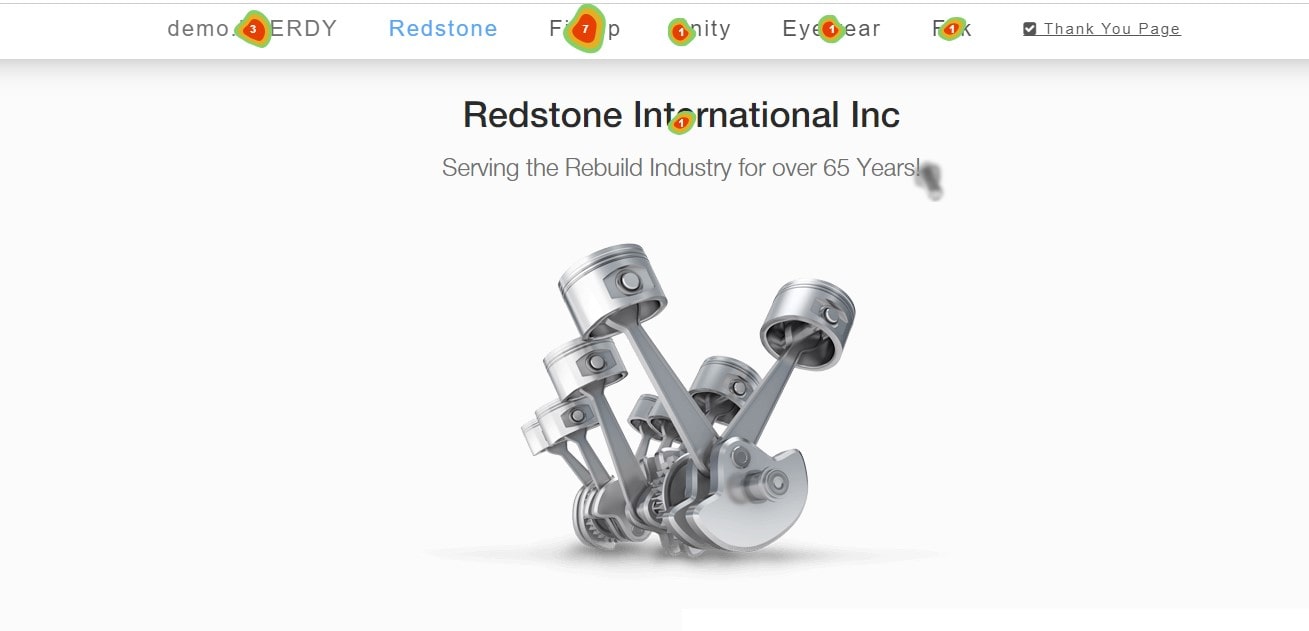
What Is A UX Analytics Tool?
UX analytics tools give companies deep insights into user behavior to optimize their websites. A comprehensive website UX analysis can highlight friction points that hurt engagement and conversions. Leveraging these advanced solutions allows you to refine your online presence, delivering an unmatched user experience.
Essential features of a top-notch UX analytics tool include:
- Detailed heatmaps
- Visitor recordings
- Conversion funnel tracking
- User feedback collection
- Form and goal analysis
With these robust capabilities, tools for UX analysis help you pinpoint the elements that captivate your audience and those needing a revamp. By analyzing clicks, scrolls, and mouse movements, you can identify areas for improvement and streamline your website’s UX design.
Visitor recordings provide a first-hand account of user interactions, revealing opportunities to enhance the user journey. User experience tracking tools help identify drop-off moments and prioritize improvements based on real behavior. Coupled with conversion funnel tracking and form analysis, these analytics tools empower you to eliminate roadblocks and deliver a seamless user experience.
Embrace the potential of UX analytics tools and watch your online presence flourish, leaving competitors in the dust as you dominate the digital landscape.
What Are The Benefits Of Using A UX Analytics Tool?
![]()
Utilizing a UX analytics tool is the key to unlocking a treasure trove of insights that can propel your online success. By delving into user behavior, these powerful analytics tools enable you to fine-tune your website for optimal performance and outpace your competition.
Top benefits of using a UX analytics tool:
- Improved user engagement
- Enhanced conversion rates
- Streamlined user journeys
- Informed decision-making
- Superior website design
Experience the power of improved user engagement by identifying trends and patterns that captivate your audience. With enhanced conversion rates, you’ll drive more sales and bolster your online presence. In addition, UX analytics tools allow you to hone in on user journeys, ensuring a seamless experience that leaves a lasting impression.
Make data-driven decisions confidently, backed by the information gleaned from these indispensable UX analytics tools. User experience UX analytics is essential for businesses that want to keep users engaged and convert effectively. Then, elevate your website’s design and functionality into a digital juggernaut that captures your users’ attention and keeps them returning for more.
Embrace the benefits of UX analytics tools and set your sights on the pinnacle of online success.
The Role Of UX Analytics Tools In Enhancing User Experience
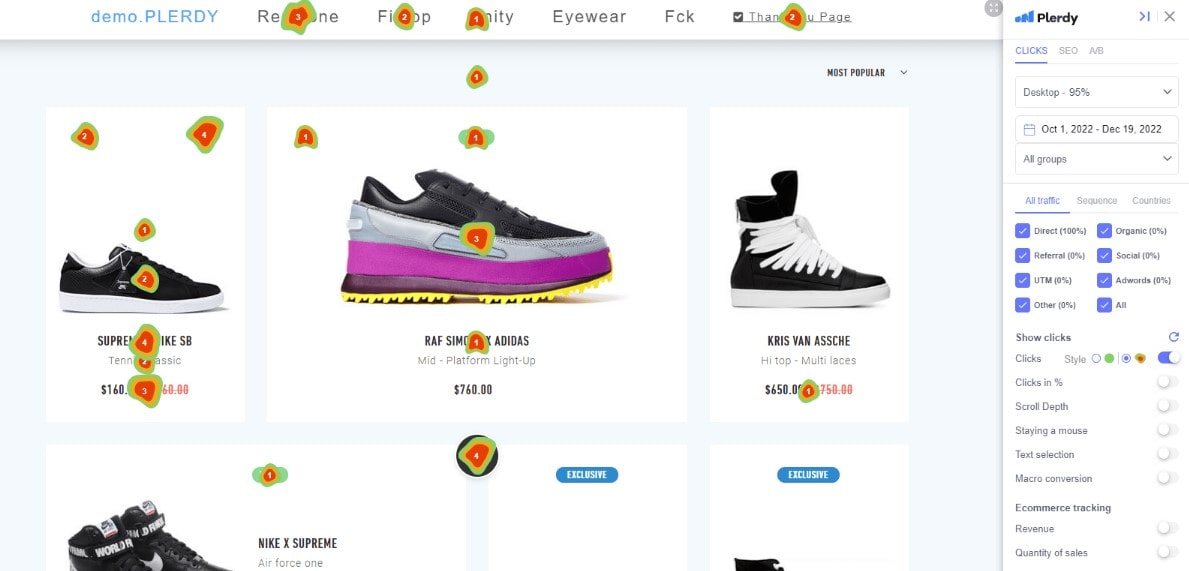
In the digital realm, a seamless user experience (UX) is pivotal in retaining visitors and fostering customer loyalty. UX analytics tools empower businesses to gain valuable insights, enabling them to fine-tune their website or application and offer a top-notch experience. By utilizing these analytics tools, companies can effectively assess user behavior, identify patterns, and uncover opportunities for improvement.
UX analytics platforms provide extensive data that illuminate user interactions with a platform. Many marketers often ask: which product analytics platform has the best UX? Before diving into specific metrics, an analytics review UX process should guide which areas of user behavior to prioritize. This invaluable information includes metrics such as:
- User flow patterns
- Click and scroll heatmaps
- Session recordings
- Conversion rate optimization
For instance, imagine a retail website needing help to retain customers. The business can identify user experience bottlenecks, such as a lengthy checkout process, and take appropriate measures to improve user happiness by utilizing UX analytics.
A well-optimized user experience translates to higher engagement, increased conversions, and, ultimately, better revenue generation. Businesses can use UX analytics tools to build a personalized experience for their target audience. In a fiercely competitive digital landscape, prioritizing UX optimization is desirable and indispensable for staying ahead.
The Growing Importance Of Data-Driven Decision Making In UX Design
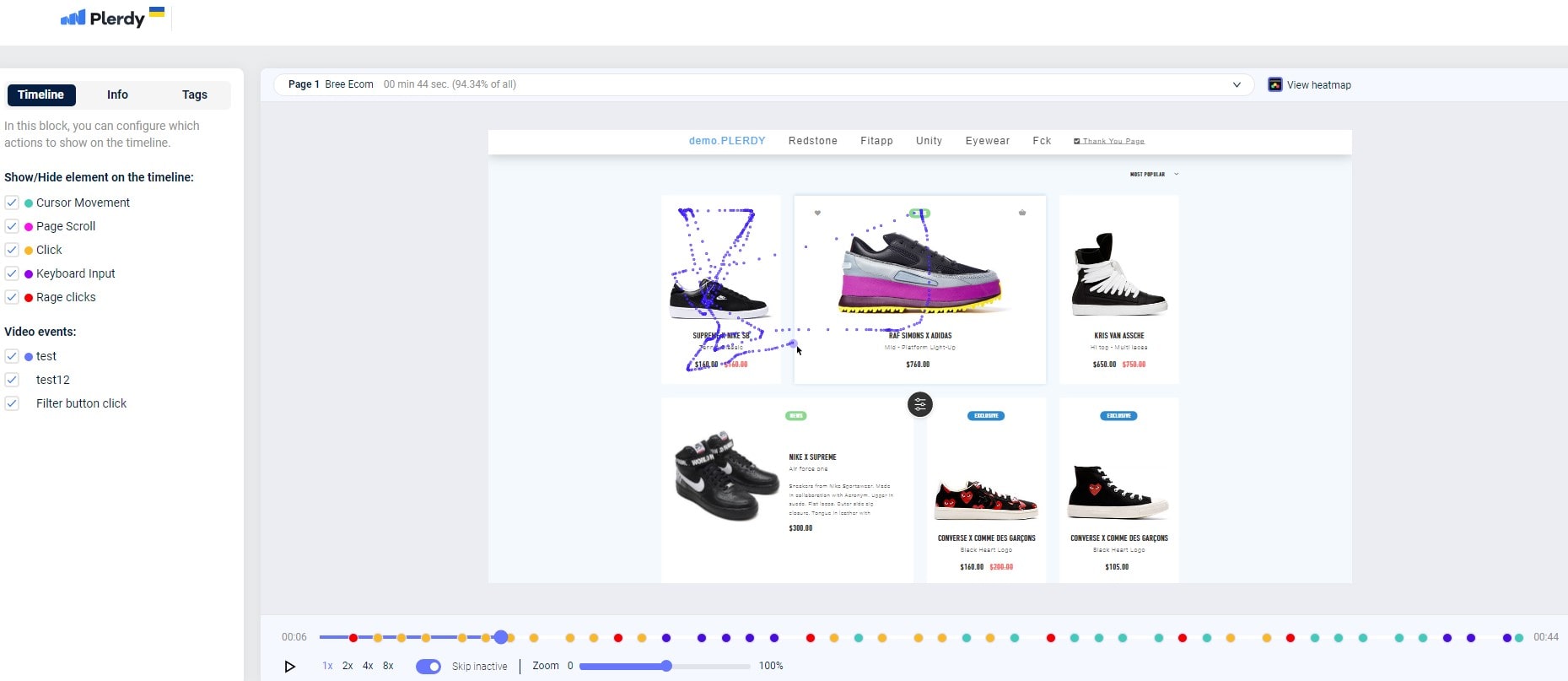
In the ever-evolving digital landscape of 2025, making decisions based on data is paramount in UX design. Businesses that embrace this approach can create more personalized, engaging, and user-centric experiences, propelling them to the forefront of their respective industries.
UX analytics tools facilitate data-driven design, as they offer many actionable insights. An effective analytics platform user experience ensures that designers can interpret and act on insights easily. These insights empower designers to make well-informed decisions that cater to users’ needs, preferences, and expectations. UX tracking tools provide detailed data to evaluate each interaction across the site journey. In addition, by leveraging data, companies can optimize their user experience, driving higher engagement and conversion rates. Customer UX analytics can also help personalize site elements based on past user behavior.
Some key aspects of data-driven UX design include:
- Identifying user pain points and addressing them proactively
- Analyzing user behavior to understand their preferences
- Iteratively testing design variations to determine the most effective solution
For example, an e-commerce platform might notice that users frequently abandon shopping carts. By utilizing UX analytics, the company can determine the root cause of this issue, such as a complex checkout process, and implement necessary changes to streamline the experience.
Incorporating data-driven decision-making in UX design enables businesses to refine their digital offerings, ensuring they are tailored to their audience’s needs. By investing in UX analytics tools, companies can stay ahead of the curve, consistently delivering exceptional user experiences that keep them returning for more.
List of Best UX Analytics Tools
Perusing this assortment of UX analyzer tools, you realize they’re not just gadgets; they’re your digital sleuthing partners, unearthing the nuances of user interactions. From the intricate tapestry of clicks to the dance of user journeys, these analyzers and trackers offer a deep dive into the psyche of your audience. Opting for free UX analytics software doesn’t mean skimping on quality; it’s about being savvy and making every dollar stretch while still gleaning top-tier insights. There are many free UX analytics tools that still offer powerful features for startups and small businesses. The beauty of these UX analytics tools lies in their ability to transform abstract data into actionable wisdom, guiding your design decisions with precision. UX website analytics turn vague metrics into clear actions that drive business value. It’s akin to having a GPS for navigating the vast ocean of user experience, ensuring you’re always on the right course.
1. Plerdy
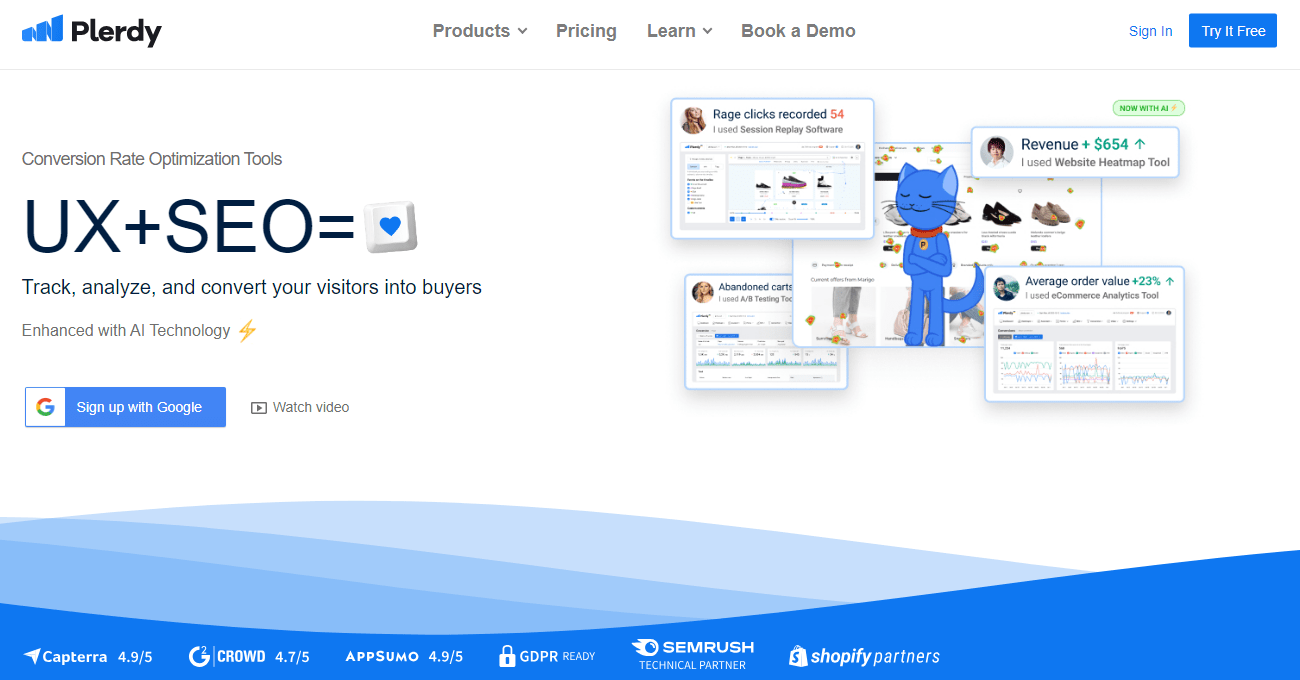
In today’s digital landscape, businesses thrive by optimizing their online presence with cutting-edge UX analytic tools. Plerdy, an innovative solution, stands out from the crowd as it provides unparalleled insights into user behavior, enabling website owners to make data-driven decisions for enhanced performance. If you’re looking for reliable user experience analysis tools, Plerdy is one of the most advanced options on the market.
Plerdy’s key features include:
- Comprehensive heatmaps
- Real-time visitor recordings
- Sales performance analysis
- SEO audit
With Plerdy’s detailed heatmaps, you can easily identify which page elements capture user attention and which fall by the wayside. Clicks, scrolling, and mouse movements reveal user engagement. To maximize impact, you might modify your website’s appearance and functionality. Plerdy’s real-time visitor records let you see user interactions and improve the user journey. Combined with form analytics, this tool assists in identifying bottlenecks in the conversion process, ensuring a seamless experience for your users.
Don’t let your competitors steal the spotlight—harness the power of Plerdy to bolster your sales performance and climb the search rankings. From comprehensive SEO audits to a bird’ s-eye view of your online performance, Plerdy is the all-in-one solution for businesses seeking online domination. Optimize your website with confidence and precision, leveraging Plerdy’s unmatched capabilities to secure your place at the pinnacle of success.
2. Hotjar
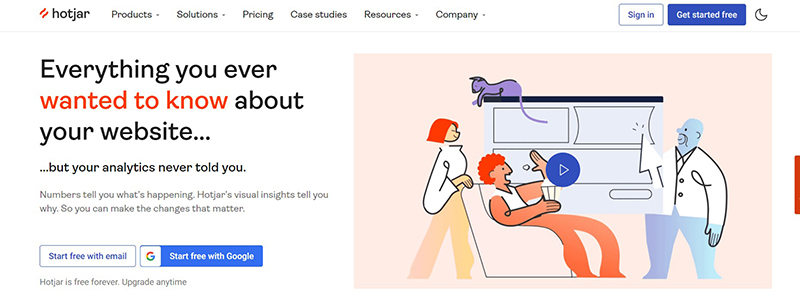
Hotjar is the ultimate tool for UX analytics, allowing businesses to enhance their online presence precisely. With its array of features that offer thorough insights into user behavior, Hotjar makes it possible to optimize your website’s performance
Key benefits of Hotjar include:
- Interactive heatmaps
- Visitor recordings
- Conversion funnel analysis
- Feedback polls
- Surveys
Visitor recordings offer a first-row seat to user interactions, shedding light on areas for improvement and simplifying the user journey. In tandem with conversion funnel analysis, Hotjar aids in identifying conversion roadblocks, ensuring a smooth experience for your visitors.
Gather invaluable feedback through polls and surveys to better understand your users’ needs and preferences. Then, embrace the power of Hotjar – a trailblazer in UX analytics – to elevate your website, outpace the competition, and secure your position at the forefront of online success.
3. Google Analytics 4
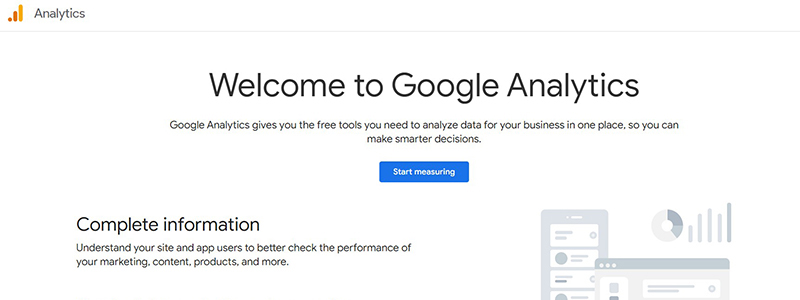
Enter the future of UX analytics with Google Analytics 4 (GA4), a trailblazing tool that enables businesses to optimize their websites through comprehensive user behavior insights. GA4 sets the stage for data-driven decision-making, allowing you to finetune your online presence and outshine the competition.
Core features of Google Analytics 4 include:
- Enhanced audience segmentation
- Event tracking
- Advanced funnel analysis
- Real-time reporting
- Cross-platform insights
Dive into GA4’s advanced audience segmentation and better understand your users. Event tracking and funnel analysis empower you to identify trends, optimize conversion paths, and streamline the user experience.
Leverage real-time reporting to stay informed about your website’s performance and make adjustments on the fly. Furthermore, GA4’s cross-platform insights enable you to analyze data from various devices, providing a holistic view of user behavior.
Unleash the potential of Google Analytics 4 and elevate your online presence. Capture your audience’s attention and secure your spot at the forefront of digital success.
4. FullStory
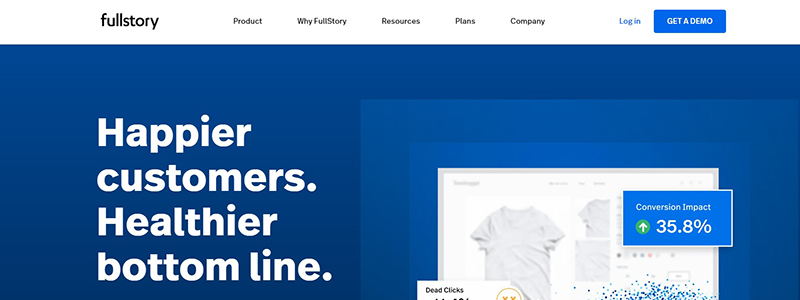
FullStory, a cutting-edge UX analytics tool, has emerged as a powerful resource for businesses seeking to optimize their digital platforms. By revealing user behavior, FullStory helps companies create seamless, user-centric experiences that boost customer engagement.
This innovative tool boasts an array of features, including:
- Session replay: Watch user interactions in real-time or recorded sessions
- Frustration signals: Detect signs of user frustration, such as rage clicks and error clicks
- Segmentation: Filter and analyze user data based on specific criteria
FullStory empowers businesses to fine-tune their UX by providing actionable data. By addressing user pain points, companies can create intuitive, enjoyable experiences that keep visitors returning for more. With its steadfast commitment to continuous improvement, FullStory has undoubtedly become an indispensable ally for businesses aiming to thrive in the digital realm, helping them stay one step ahead of the competition.
5. Mixpanel
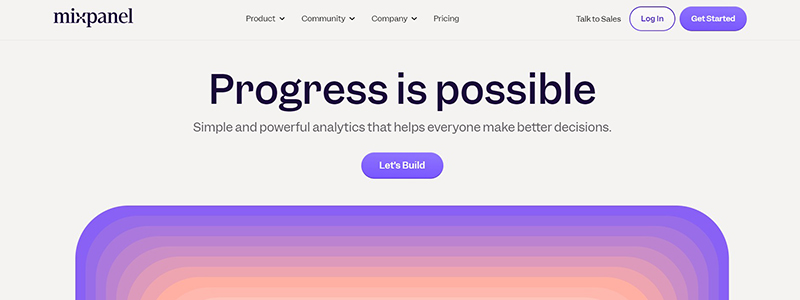
Mixpanel, a groundbreaking UX analytics tool, is well known for its capacity to assist companies in optimizing their online presence. By offering in-depth insights into user behavior, Mixpanel enables businesses to create customized experiences that increase customer satisfaction.
This state-of-the-art tool offers an impressive array of features, such as:
- Event tracking: Monitor user interactions with specific elements on your site
- Funnel analysis: Identify conversion bottlenecks and optimize user journeys
- Retention tracking: Evaluate user loyalty and identify factors that drive repeat visits
For instance, a subscription-based news website might need a higher churn rate. Using Mixpanel’s retention tracking feature, the site owner could determine that users must re-engage with the content due to a lack of personalization. This insight would then prompt the implementation of tailored content recommendations, ultimately boosting user retention.
Mixpanel is a valuable asset for businesses aiming to refine their digital platforms. By harnessing the tool’s robust capabilities, companies can create bespoke experiences that cater to their target audience’s preferences and needs, ensuring they remain competitive in today’s rapidly evolving online landscape. Moreover, with its unwavering commitment to delivering actionable insights, Mixpanel has earned its place as a cornerstone of successful digital strategies.
6. Crazy Egg
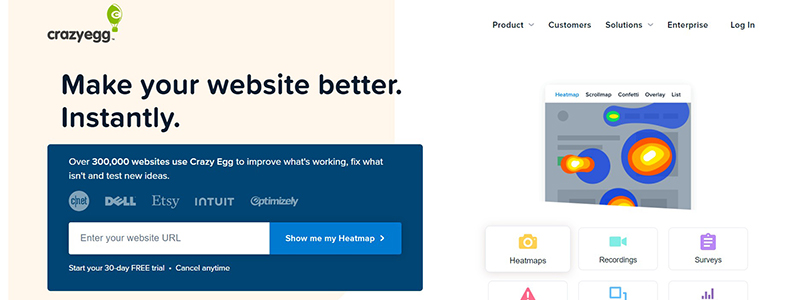
Crazy Egg, a prominent UX analytics tool, helps organizations improve their digital platforms. By uncovering user behavior, Crazy Egg assists companies in developing user-focused experiences that enhance customer satisfaction and engagement.
- Heatmaps: Visualize user interactions and identify popular areas on your site
- Scroll maps: Understand how far users scroll down your pages and optimize content placement
- A/B testing: Experiment with different design elements to identify the best-performing version
For example, an e-commerce store might notice that a specific product page has low conversion rates. By using Crazy Egg’s heatmap feature, the store owner could identify that users are not clicking on the “Add to Cart” button, perhaps due to its obscure location. This insight would lead to redesigning the page layout, ultimately improving user experience and increasing sales.
7. Adobe Analytics

Adobe Analytics, a powerful UX analytics tool, has garnered recognition for its ability to offer businesses a comprehensive understanding of user behavior. By harnessing this tool, companies can optimize their digital experiences, ensuring they cater to their audience’s unique needs and preferences.
- Track customer journeys: Gain insights into user interactions across various touchpoints
- Segment users: Identify different user groups based on behavior, preferences, and demographics
- Analyze real-time data: Make data-driven decisions with up-to-the-minute information
Take, for instance, a digital marketing agency that wishes to boost engagement levels on its blog. By leveraging Adobe Analytics, the agency can identify the topics that resonate most with its audience, enabling them to create tailored content that drives higher levels of interaction.
In a nutshell, Adobe Analytics allows businesses to learn deeply about user behavior, empowering them to make well-informed, data-driven decisions that elevate their digital experiences. With its robust capabilities and commitment to delivering valuable insights, Adobe Analytics has proven an indispensable resource for businesses striving for success in today’s competitive landscape.
8. Amplitude
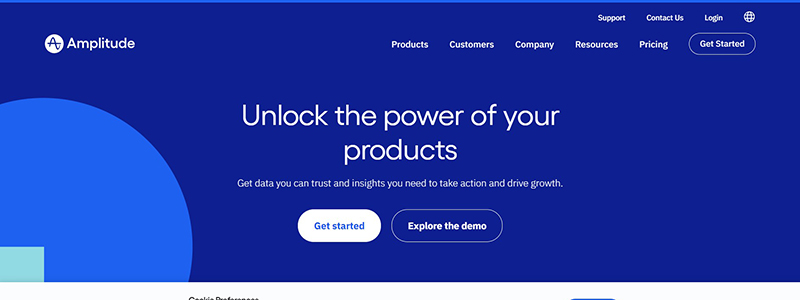
UX analytics tool Amplitude is revolutionizing digital experience optimization. This innovative approach allows firms to analyze user behavior and adapt their digital services to changing client needs.
Widely celebrated for its diverse range of capabilities, Amplitude helps companies:
- Visualize user paths: Understand the routes users take while navigating digital platforms
- Monitor engagement: Keep a pulse on user activity levels and identify opportunities for improvement
- Conduct A/B testing: Experiment with different elements to optimize the overall user experience
Picture a budding e-commerce store that’s keen on boosting its conversion rates. Amplitude helps the store identify user journey bottlenecks and make focused adjustments. As a result, the store can effectively enhance its customer experience, driving greater satisfaction and loyalty.
In short, Amplitude has emerged as an invaluable ally for businesses seeking to thrive in today’s fiercely competitive digital landscape. By offering a comprehensive suite of features that cater to businesses’ dynamic needs, Amplitude is steadfastly propelling organizations toward new heights of digital excellence.
9. Mouseflow
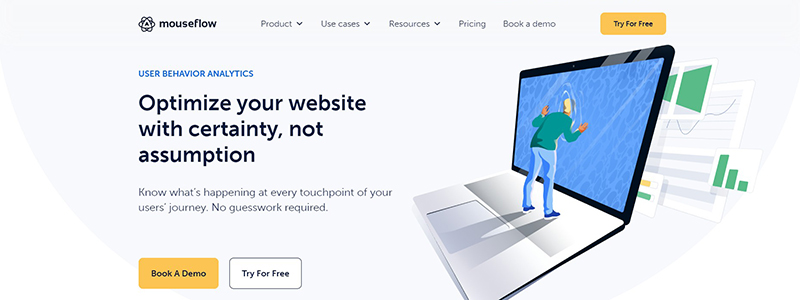
Mouseflow, an innovative UX analytics tool, has rapidly gained popularity for its ability to unlock insights into user behavior on websites and digital platforms. This state-of-the-art solution allows businesses to fine-tune their online presence, elevating the user experience.
Mouseflow’s impressive suite of features includes:
- Heatmaps: Visualize user interactions, such as clicks and scrolls, to identify popular areas and potential pain points
- Session replays: Analyze user navigation to understand their journey better and optimize the overall experience
- Form Analytics: Uncover bottlenecks in form completion processes, enabling smoother conversions
Imagine a travel agency striving to enhance its online booking system. With Mouseflow at its disposal, the agency can analyze user behavior, identifying areas of friction or confusion within the booking process. By addressing these issues and streamlining the user journey, the agency can increase customer satisfaction and loyalty.
By delivering a wealth of actionable insights and robust features, Mouseflow has solidified its position as an indispensable asset for companies aiming to excel in user experience.
10. Optimizely
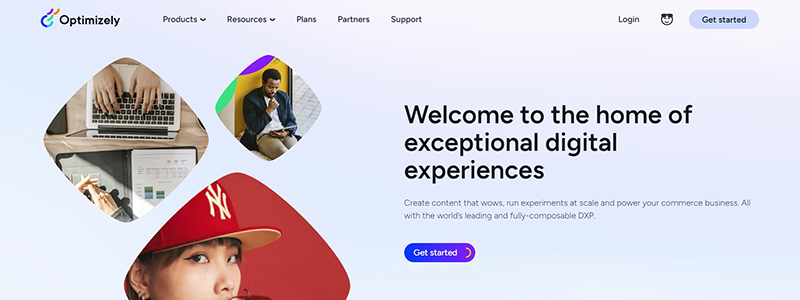
Optimizely, a perfect UX analytics tool, has carved out a niche by offering a sophisticated platform to streamline experimentation and optimization.
Optimizely boasts an array of compelling features, such as:
- A/B testing: Evaluate different variations of a web page
- Multivariate testing: Examine multiple elements simultaneously for a comprehensive understanding of their impact on user behavior
- Personalization: Tailor content to specific audience segments, promoting relevance and driving engagement
Picture an online retailer striving to boost sales by revamping its homepage. Through Optimizely’s A/B testing capabilities, the retailer can evaluate multiple layouts, ultimately identifying the most successful design. This process allows the retailer to optimize its site with data-backed confidence, ultimately maximizing conversion rates.
In short, Optimizely equips businesses with the tools they need to turn over every stone in their pursuit of digital excellence. Optimizely sets the stage for companies to thrive in the ever-evolving realm of user experience by facilitating data-driven decision-making and offering a versatile suite of features.
11. Pendo
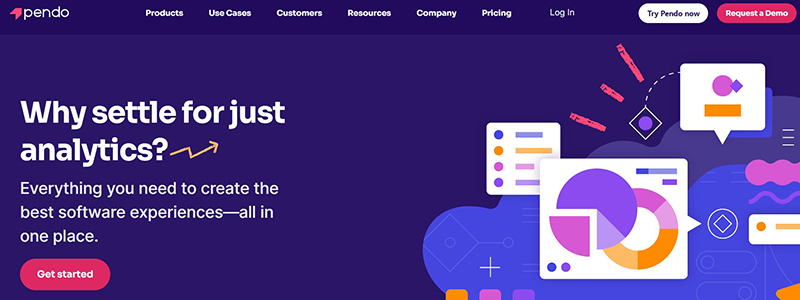
Pendo, a nice UX analytics tool, provides invaluable insights into user behavior, empowering businesses to make informed decisions about their digital products.
Key Pendo features include:
- In-app guidance: Offer tailored, contextual help to users navigating your site or app
- User feedback: Collect valuable input directly from your audience to inform product improvements
- Segmentation: Analyze user behavior across various audience groups for targeted insights
Imagine a software company striving to reduce churn and increase customer satisfaction. With Pendo’s in-app guidance feature, the company can create interactive walkthroughs, simplifying the onboarding process for new users. Moreover, user feedback collection allows the company to understand its users’ pain points, ultimately addressing these issues and enhancing the overall experience.
By leveraging Pendo’s robust analytics capabilities, businesses can take a deep dive into the world of user experience, uncovering patterns and insights that drive actionable improvements. With Pendo in their corner, companies can rest assured that they are well-equipped to deliver a top-tier experience to their audience, fostering loyalty and success in the digital sphere.
12. UserTesting

UserTesting is an exceptional UX analytics tool that equips businesses with the insights necessary to create top-notch user experiences. By harnessing real user feedback, this platform allows for an in-depth understanding of what users truly need and desire, paving the way for effective product improvements.
UserTesting’s comprehensive suite of features includes:
- Live video recordings: Observe user interactions in real time to glean crucial insights
- Customized user panels: Recruit specific demographics to understand target audiences better
- Task-based testing: Assign specific objectives for users to complete, revealing potential pain points
Consider an e-commerce website eager to boost conversion rates. UserTesting empowers the business to recruit target customers and observe them as they navigate the site, offering invaluable data on their preferences and pain points. By identifying areas of friction, the website can implement changes that streamline the user experience and ultimately increase sales.
With UserTesting, companies can get to the heart of user experience, harnessing real feedback to make well-informed product decisions. By capitalizing on this powerful tool, businesses can stay ahead of the curve and deliver a user experience that meets and exceeds their customers’ expectations, fostering loyalty and driving success in the digital realm.
13. VWO
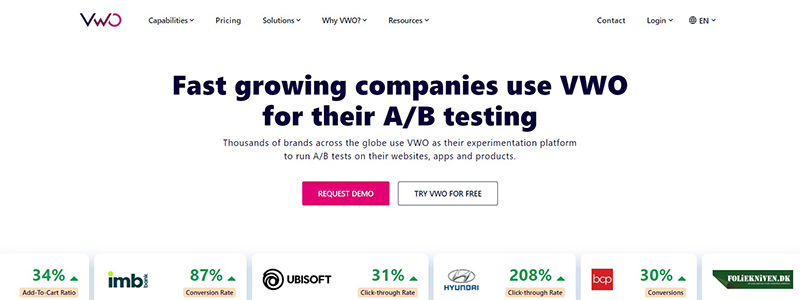
VWO is a premier UX analytics tool that offers businesses the key to unlocking stellar user experiences. This all-in-one platform enables companies to optimize their digital presence, ensuring they always hit the mark with their target audience.
- A/B testing: Compare different versions of your site to determine which performs best
- Multivariate testing: Analyze multiple variables simultaneously for even deeper insights
- Heatmaps: Visualize user interactions on your site to identify popular and neglected areas
Picture a travel agency aiming to boost its online bookings. Using VWO, the company can run A/B tests to determine which website layout and call-to-action elicit the highest conversion rates. Additionally, with heatmaps, the agency can pinpoint sections of the site that draw the most attention and focus on enhancing those areas.
By leveraging VWO, businesses can optimize their digital presence and ensure they cater to their customers’ needs. This powerful tool allows companies to fine-tune their UX, fostering customer loyalty and bolstering their bottom line. In the ever-evolving digital landscape, VWO equips businesses with the insights needed to thrive and stay ahead of the competition.
14. Woopra
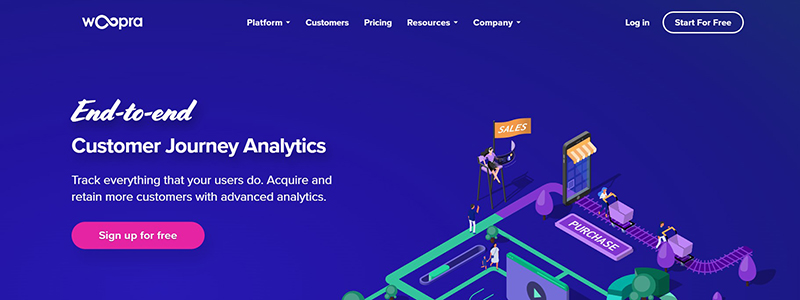
Woopra, a top-tier UX analytics tool, empowers businesses to analyze their customers’ online behavior. This cutting-edge platform enables companies to refine their digital strategies, creating a seamless user experience and driving customer satisfaction.
Key features of Woopra include:
- Real-time tracking: Monitor customer actions as they unfold
- Customer profiles: Gather detailed insights into individual user behaviors
- Funnel analysis: Identify bottlenecks and drop-off points in user journeys
Envision a thriving e-commerce store seeking to enhance its online presence. With Woopra’s real-time tracking, the store can identify popular products and adjust its inventory accordingly. Customer profiles enable businesses to craft personalized marketing campaigns that resonate with their target audience, increasing conversions. Through funnel analysis, the store can pinpoint areas where it could drop off, allowing adjustments to improve the overall experience.
15. Heap

Heap, a trailblazing UX analytics tool, brings data-driven decision-making to the forefront of your business. Its powerful features enable companies to delve into customer interactions, delivering actionable insights that lead to better user experiences and increased engagement.
Heap’s standout features include:
- Auto-capture: Track all user interactions without manual tagging
- Retroactive analysis: Access historical data without the need for pre-defined tracking
- Custom event tracking: Define and track specific user actions tailored to your business goals
Consider a bustling online marketplace seeking to boost customer retention. By leveraging Heap’s auto-capture functionality, the platform can monitor user behavior without the hassle of manual tagging. This comprehensive data collection allows the marketplace to identify trends and patterns in customer engagement, leading to informed strategic decisions.
With Heap’s retroactive analysis, businesses can revisit historical data to spot missed opportunities and identify areas for improvement. Analytics UX design plays a crucial role in interpreting data to guide interface improvements. Custom event tracking, meanwhile, allows the marketplace to focus on specific actions crucial to their success, such as item views, clicks, and conversions.
In summary, Heap is a powerful UX analytics tool that equips businesses with the knowledge they need to optimize their online presence. By harnessing Heap’s potential, companies can transform raw data into actionable insights, paving the way for improved user experiences and long-term success.
FAQ for Best UX Analytics Tools for User Research
What is a UX analytics tool, and why do businesses need it?
A UX analytics tool helps businesses analyze user behavior to optimize website design and improve user experience. By tracking interactions, such as clicks, scrolls, and form submissions, these tools provide valuable insights that enhance engagement, streamline navigation, and boost conversion rates. Plerdy and similar tools make data-driven decision-making easier for businesses aiming to refine their UX.
How do UX analytics tools improve website performance?
UX analytics tools like Plerdy analyze visitor behavior through heatmaps, session recordings, and conversion funnel tracking. These insights allow businesses to identify pain points, improve site navigation, and remove obstacles in the user journey, ultimately enhancing performance and increasing conversions.
What features should I look for in a UX analytics tool?
The best UX analytics tools offer features like heatmaps, user session recordings, conversion tracking, form analysis, and real-time visitor insights. Plerdy, for example, combines these functionalities, providing businesses with a comprehensive UX analysis tool to optimize website usability.
Can UX analytics tools help with SEO?
Yes! UX analytics tools indirectly impact SEO by improving user engagement, reducing bounce rates, and optimizing website structure. Plerdy, for instance, offers SEO audit features alongside UX analysis, helping businesses refine both user experience and search engine rankings.
Is Plerdy a good choice for UX analytics?
Absolutely! Plerdy provides powerful UX analytics features, including heatmaps, visitor tracking, and conversion optimization tools. Its seamless integration with SEO analysis makes it a top-tier solution for businesses looking to enhance their digital presence through data-driven insights.
Bottom Line
As we wrap up our exploration of the 15 Best UX Analytics Tools in 2024, it’s clear that these powerful solutions have become indispensable in today’s digital realm. By offering a bird’ s-eye view of user behavior, these tools allow businesses to refine their websites, streamline the user experience, and ultimately drive better results. The variety of tools we’ve covered caters to different needs, goals, and budgets, ensuring an ideal fit for everyone.
Some key takeaways include:
- Harnessing data-driven insights for smart decision-making
- Improving user engagement and conversion rates
- Balancing quantitative and qualitative analysis for a holistic view
We couldn’t help but notice Plerdy’s impressive capabilities in UX analysis. With its robust set of features, it has the potential to be a game-changer for businesses eager to level up their online presence. Try Plerdy with its free trial and experience firsthand the benefits of using a top-tier UX analytics tool.
In conclusion, investing time and resources into the right UX analytics tool is a no-brainer. From Google Analytics to Plerdy, UXCAM, and more – these platforms empower businesses to build user-centric websites that leave a lasting impression. So, don’t hesitate; take the plunge and start reaping the rewards of these innovative tools today!
